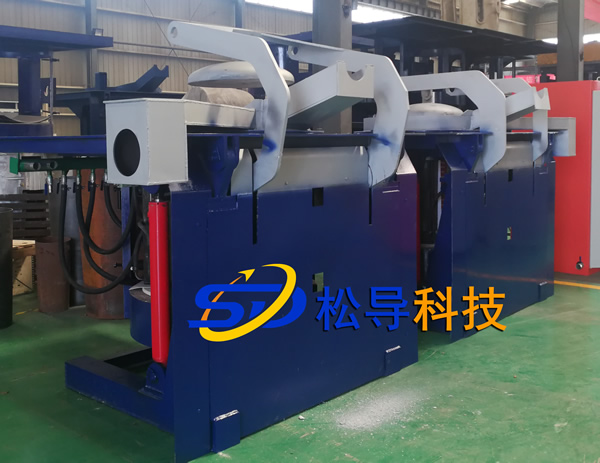Induction melting furnace common 12 major failures
1. No reaction in the system at startup
1 rectifier board failure;
2 overcurrent and overvoltage protection actions;
3 main switch is not well;
4 control the power adjustment potentiometer is damaged or broken;
5 rectifier control power supply is partially broken.
2, only the DC voltmeter has an indication, the other does not respond
1 inverter board and inverter circuit failure;
2 Inverter power failure. The inverter pulse has no 22V power supply.
Note: The control power transformer is easily damaged when the power phase voltage is higher than 240V.
3, can not start successfully when starting, and the DC current is very large, the DC voltage is very low (tens of volts)
1 There is a direct short circuit phenomenon in the inverter part (such as short circuit between copper rows, electric capacitor breakdown, etc.)
2 Inverter control circuit and signal acquisition part have problems (open or short circuit)
3 Inverted thyristors have multiple damage phenomena (measured by multimeter R×1 file).
4. There are occasional frequency sounds at the start, but each meter swings, or the instruments swing after starting, after the power is boosted, overcurrent or overvoltage
1 Inverter control board is defective.
2 The minimum tf working angle is not adjusted properly.
3 Water cable break or cable screw loose.
4 furnace short circuit or ground, the voltage circuit may be shorted on the output side.
5 thyristor is bad.
5, one main circuit, the air starts to trip, or over-current protection, even if it happens by accident, there will be abnormal sound, one liter of power makes the over-current
1 is generally a breakdown of a rectifier thyristor.
2 The performance of the thyristor is degraded, or the blocking ability in a certain direction becomes a diode.
3 There is a short circuit in the rectifier circuit.
6, can start, but the reactor sounds dull. The meter occasionally oscillates, and the DC voltage rises to 500V.
1 The main circuit is out of phase (the general constant power board lacks phase and there is no DC voltage output);
2 control circuit lacks pulse;
3 One of the rectifier thyristors cannot be touched or cannot be maintained, and the gate is open or shorted.
7, can start, but the intermediate frequency voltage and DC voltage ratio is large, the voltage is low, the DC current is very large
1 Inverter thyristor breakdown of a certain bridge wall;
2 A certain thyristor does not work (it can be used to measure the tube voltage drop directly when using a multimeter AC file when working at a small voltage. No voltage may break down, but also pay attention to whether the adjacent bridge wall does not work, for a single tube bridge wall It is said that if the positive and negative voltages are consistent, the relevant circuit can be checked. For the two series of two thyristor series circuits, there are two cases. The same single-tube circuit generally has no pulses for both tubes, and the voltage is positive and negative. Note that the thyristor that bears the forward voltage does not work, see if there is a control pulse, whether the polarity is normal, and whether the gate is open).

3 The inverter control circuit is abnormal.
4 The load does not match, or the minimum TF angle is not set properly.
Note: When KK thyristor breakdown, the secondary parallel diode of the inverter pulse transformer will also be broken down, which will cause no output of the inverter pulse. Pay attention to the inspection when replacing the new thyristor. The three walls of the bridge work.
8. The DC voltage is unstable, or a certain range is unstable, the meter is pendulum, and the reactor has a broken sound.
1 trigger pulse is unstable;
2 the characteristics of the rectifier thyristor are poor;
3 The main circuit has poor contact;
4PI mediator has problems and oscillates;
5 control circuit leads the way to interference.
9. The intermediate frequency voltage is unstable, and the DC voltage is unstable.
1 Inverter thyristor is defective;
2 Inverter pulse is unstable;
3 The minimum TF angle is set incorrectly;
4 angular load loop contact or fire and line;
There is a problem with the 5PI regulator oscillation;
10, normal start, the voltage rises to a certain extent, suddenly appears to restart,
1 The minimum angle adjustment is too small;
2 The board frequency adjustment is not suitable.
11. The new furnace or the cool furnace is well started and can work normally. When the furnace is hot or full of molten steel, it will stop and it will be difficult to start.
Mainly because the circuit board frequency adjustment is not suitable, the angle is too small.
12, IF equipment can start, overcurrent when power increases, common reasons:
1 IF transformer is damaged or bad,
2 Inverter pulse transformer is damaged or defective,
3 inverter thyristor soft breakdown or intermittent,
4 intermediate frequency transformer primary series capacitor leakage,
5Electrical capacitors are soft-punched, and the furnace rings or copper bars are not well grounded or slightly short-circuited.















